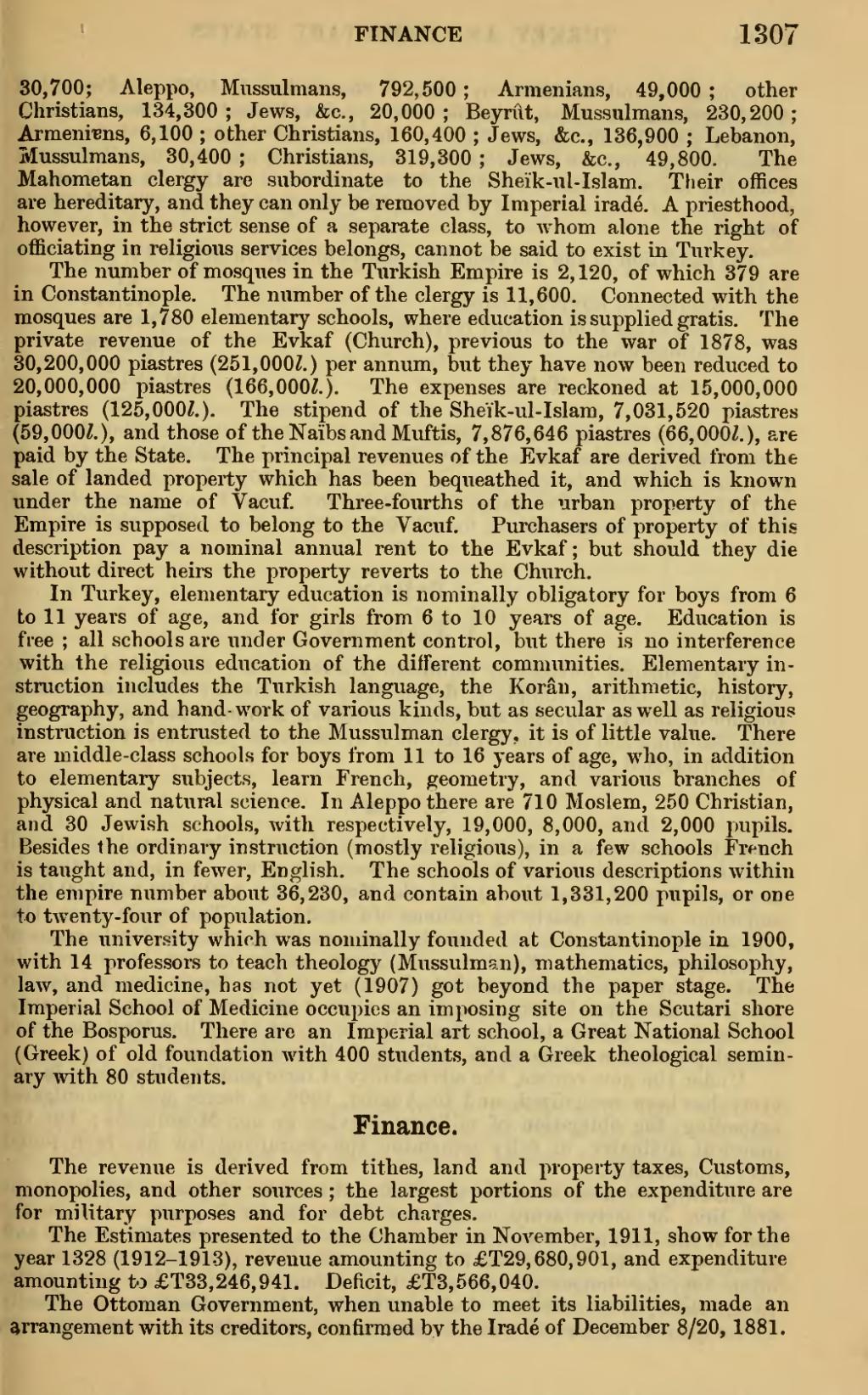" FINANCE 1307
30,700; Aleppo, Mussulmans, 792,500; Armenians, 49,000; other Christians, 134,300; Jews, &c., 20,000; Beynlt, Mussulmans, 230,200; Armenians, 6,100 ; other Christians, 160,400 ; Jews, &c., 136,900 ; Lebanon, Mussulmans, 30,400 ; Christians, 319,300 ; Jews, &c., 49,800. The Mahometan clergy are subordinate to the Sheik-ul-Islam. Their offices are hereditary, and they can only be removed by Imperial irade. A priesthood, however, in the strict sense of a separate class, to Avhom alone the right of officiating in religious services belongs, cannot be said to exist in Turkey.
The number of mosques in the Turkish Empire is 2,120, of which 379 are in Constantinople, The number of the clergy is 11,600. Connected with the mosques are 1,780 elementary schools, where education is supplied gratis. The private revenue of the Evkaf (Church), previous to the war of 1878, was 30,200,000 piastres (251,000Z.) per annum, but they have now been reduced to 20,000,000 piastres (166,000Z.). The expenses are reckoned at 15,000,000 piastres (125,000Z.). The stipend of the Sheik-ul-Islam, 7,031,520 piastres (59,000Z.), and those of the Naibs and Muftis, 7,876,646 piastres (66,000Z.), are paid by the State. The principal revenues of the Evkaf are derived from the sale of landed property which has been bequeathed it, and which is known under the name of Vacuf. Three-fourths of the urban property of the Empire is supposed to belong to the Vacuf. Purchasers of property of this description pay a nominal annual rent to the Evkaf; but should they die without direct heirs the property reverts to the Church.
In Turkey, elementary education is nominally obligatory for boys from 6 to 11 years of age, and for girls from 6 to 10 years of age. Education is free ; all schools are under Government control, but there is no interference with the religious education of the different communities. Elementary in- struction includes the Turkish language, the Koran, arithmetic, history, geography, and hand- work of various kinds, but as secular as well as religious instruction is entrusted to the Mussulman clergy, it is of little value. There are middle-class schools for boys from 11 to 16 years of age, who, in addition to elementary subjects, learn French, geometry, and various branches of physical and natural science. In Aleppo there are 710 Moslem, 250 Christian, and 30 Jewish schools, with respectively, 19,000, 8,000, and 2,000 pupils. Besides the ordinary instruction (mostly religious), in a few schools French is taught and, in fewer, English, The schools of various descriptions within the empire number about 36,230, and contain about 1,331,200 pupils, or one to tAventy-four of population.
The university which was nominally founded at Constantinople in 1900, with 14 professors to teach theology (Mussulman), mathematics, philosophy, law, and medicine, has not yet (1907) got beyond the paper stage. The Imperial School of Medicine occupies an imposing site on the Scutari shore of the Bosporus. There are an Imperial art school, a Great National School (Greek) of old foundation with 400 students, and a Greek theological semin- ary with 80 students.
Finance.
The revenue is derived from tithes, land and property taxes. Customs, monopolies, and other sources ; the largest portions of the expenditure are for military purposes and for debt charges.
The Estimates presented to the Chamber in November, 1911, show for the year 1328 (1912-1913), revenue amounting to £T29,680,901, and expenditure amounting to £T33,246,941. Deficit, £T3,566,040,
The Ottoman Government, when unable to meet its liabilities, made an arrangement with its creditors, confirmed by the Irade of December 8/20, 1881.
